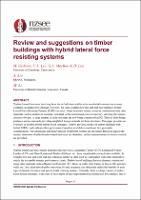| dc.description.abstract | Timber-framed structures have long been the default structural form for residential construction in many countries, including New Zealand. However, for some complex low-rise and mid-rise buildings, hybrid Lateral Force Resisting Systems (LFRS) are used, where structural timber is used in combination with other materials, such as reinforced concrete, structural steel or reinforced concrete masonry, allowing the seismic criteria to be met. A large number of such structures are now being constructed in NZ. There is little design guidance and no standards providing simplified design methods for these structures. This paper provides an overview of modern hybrid timber-based structures, reviews previous studies on timber buildings with hybrid LFRSs, and evaluates their performance based on available research and first-principles considerations. The advantages and disadvantages of different systems are discussed. Research gaps in the seismic behaviour of hybrid timber-based structures are identified, and recommendations for future research are provided. | |

